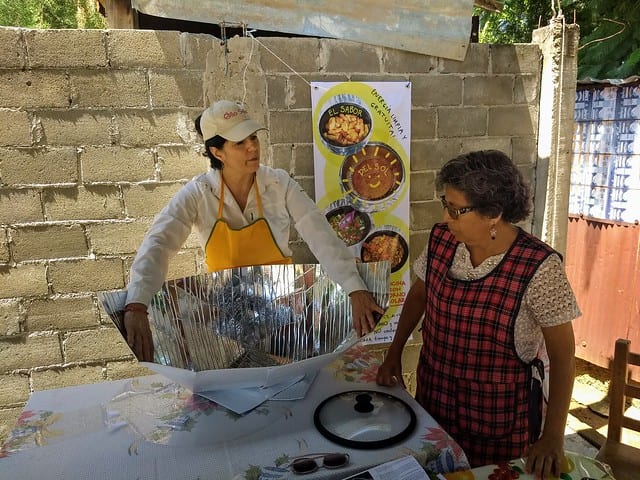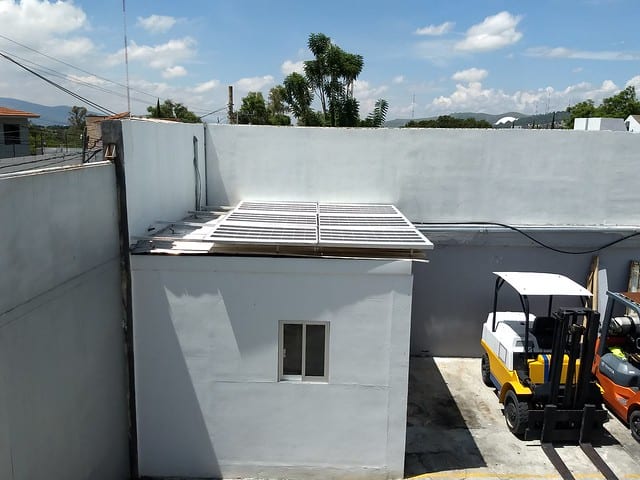Mexican Women Use Sunlight Instead of Firewood or Gas to Cook Meals
Por Emilio Godoy (IPS)

HAVANA TIMES – Reyna Díaz cooks beans, chicken, pork and desserts in her solar cooker, which she sets up in the open courtyard of her home in a poor neighborhood on the outskirts of this town in southwestern Mexico.
“My family likes the way it cooks things. I use it almost every day, it has been a big help to me,” Díaz told IPS as she mixed the ingredients for cochinita pibil, a traditional pork dish marinated with spices and achiote, a natural coloring.
She then placed the pot on the aluminum sheets of the cooker, which reflect the sunlight that heats the receptacle.
[pullquote]“I learned while working with the local women. It was hard, like breaking stones; people knew nothing about it. Now people are more open, because there is more information about the potential of solar energy. In rural areas, people understand it more.” — Lorena Harp [/pullquote]
Before receiving the solar cooker in March, Díaz, who sells atole, a traditional hot Mexican drink based on corn or wheat dough and is raising her son and daughter on her own, did not believe it was possible to cook with the sun’s rays.
“I didn’t know it could be done, I wondered if the food would actually be cooked. It’s a wonderful thing,” said this resident of the poor neighborhood of Vicente Guerrero, in Villa de Zaachila, a municipality of 43,000 people in the state of Oaxaca, some 475 km south of Mexico City.
One thing the inhabitants of Vicente Guerrero have in common is poverty. But although they live in modest houses that in some cases are tin shacks lining unpaved streets and have no sewage system, they do have electricity and drinking water. The women alternate their informal sector jobs with the care of their families.
Diaz used to cook with firewood and liquefied petroleum gas (LPG), which she now uses less so it lasts longer. “I’ve saved a lot,” she said.
Women in this neighborhood were taught how to use the solar cookers and then became promoters, organizing demonstrations in their homes to exchange recipes, taste their dishes and spread the word about the benefits and positive changes that the innovative stoves have brought.
The solar cookers are low-tech devices that use reflective panels to focus sunlight on a pot in the middle.
Their advantages include being an alternative for rural cooking, because they make it possible to cook without electricity or solid or fossil fuels, pasteurizing water to make it drinkable, reducing logging and pollution, helping people avoid breathing smoke from woodstoves, and using renewable energy.
The drawbacks are that they do not work on rainy or cloudy days, it takes a long time to cook the food, compared to traditional stoves, and they have to be used outdoors.
In Mexico, a country of 130 million people, some 19 million use solid fuels for cooking, which caused some 15,000 premature deaths in 2016 from the ingestion of harmful particles, according to data from the National Institute of Statistics and Geography (Inegi).

The main fuel consumed by 79 percent of these households is LPG, followed by wood or charcoal (11 percent) and natural gas (seven percent).
In Oaxaca, gas and firewood each account for 49 percent of household consumption.
Of the state’s more than four million inhabitants, 70 percent were living in poverty in 2016 and nearly 27 percent in extreme poverty, according to Inegi. Twenty-six percent lived in substandard, crowded housing and 62 percent lacked access to basic services.
Oaxaca is also one of the three Mexican states with the highest levels of energy poverty, which means households that spend more than 10 percent of their income on energy.
Solar cookers can help combat the deprivation.
They first began to be distributed in Oaxaca in 2004. In 2008, activists created the initiative “Solar energy for mobile food stalls in Mexico”, sponsored by three Swiss institutions: the city of Geneva, the SolarSpar cooperative and the non-governmental organisation GloboSol.
Cocina Solar Mexico, a collective dedicated to the use of solar energy for cooking, was founded in 2009. With the support of the non-governmental Solar Household Energy (SHE), based in Washington, an economical, light-weight prototype was built.
In 2016, SHE launched a pilot project in indigenous communities to assess how widely it would be accepted.
“I learned while working with the local women. It was hard, like breaking stones; people knew nothing about it. Now people are more open, because there is more information about the potential of solar energy. In rural areas, people understand it more,” Lorena Harp, head of the initiative, told IPS.
The four-litre pot, which has a useful life of five to 10 years, costs about $25, of which SHE provides half. The group has distributed about 200 solar cookers in 10 communities.
Harp said it is a gender issue, because “women are empowered, they have gained respect in their families.”
Despite its potential, Oaxaca does not take advantage of its high levels of solar radiation. Last June, it was listed among the 10 Mexican states with the lowest levels of distributed (decentralized) generation, less than 500 kilowatts, connected to the national power grid, according to the government’s Energy Regulatory Commission (CRE).

In the first half of the year, Oaxaca had an installed photovoltaic capacity of 6.69 megawatts with 747 interconnection contracts, in a country where distributed generation only involves solar energy.
This Latin American country registered 17,767 contracts for almost 125 megawatts (MW), almost the same volume as in the same period in 2018 -when they totaled 35,661 for 233.56 MW, although there were more permits. Since 2007, CRE has registered 112,660 contracts for 817.85 MW of solar power.
Luís Calderón, president of the Oaxaca Energy Cluster, says things have evolved quickly.
But “there is a lack of precise, reliable information and certainty about the savings achieved with distributed generation, which is generated for self-consumption while the surplus is fed into the grid. In addition, there is no policy in the state,” Calderón, also a member of the National Solar Energy Association, told IPS.
In 2018, Mexico registered a total installed capacity of 70,000 MW, three percent more than the previous year. Gas-fired combined cycle plants contributed 36 percent, conventional thermal 17 percent, hydroelectric 18 percent, coal almost eight percent, wind just under seven percent, and solar only 2.6 percent.
But the government of left-wing President Andrés Manuel López Obrador, who took office in December, is driving the exploitation of fossil fuels and standing in the way of the growth of renewable energies.
It plans to modify the Business Ecocredit initiative, led by the government’s Electric Energy Saving Trust for micro, small and medium enterprises for the acquisition of efficient appliances. The measures include eliminating the 14 percent subsidy and a limit of some 20,000 dollars in financing, but the government has yet to define its future.
In addition, the Oaxaca government’s plan to create two cooperatives for energy for agricultural irrigation does not yet have the 1.75 million dollars needed for two 500-kilowatt solar plants in the municipality of San Pablo Huixtepec to serve 1,200 farmers in 35 irrigation units.
The local women don’t plan to stop using the solar cookers, in a neighborhood ideal for deploying solar panels and water heaters. “We’re going to keep using it, we’ve seen that it works. We’re going to promote this,” Díaz said, while checking that her stew wasn’t burning.
The SHE assessment found that the solar cookers were widely accepted and have had a positive impact, as nearly half of the local women who use them have reduced by more than 50 percent their use of stoves that cause pollution. Some use the pots up to six times a week, and they have proven to be high quality, durable and affordable. Users also report that the solar cookers have saved them time.
Harp said more partners and government support were needed. “There’s still a long way to go, there are many shortfalls. Something is missing to generate truly widespread use, perhaps a comprehensive policy,” she said.




